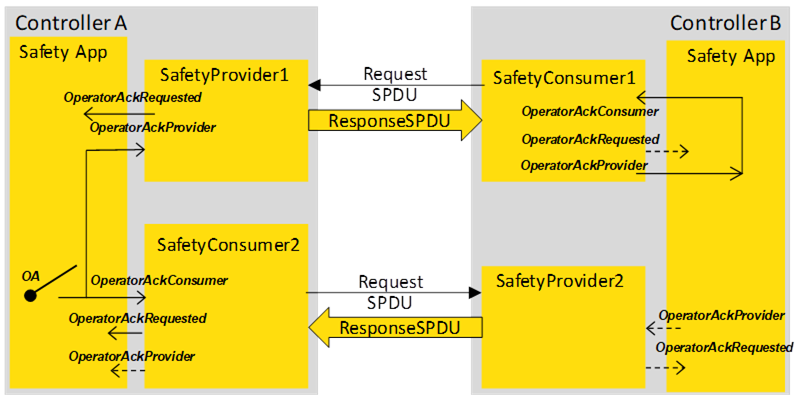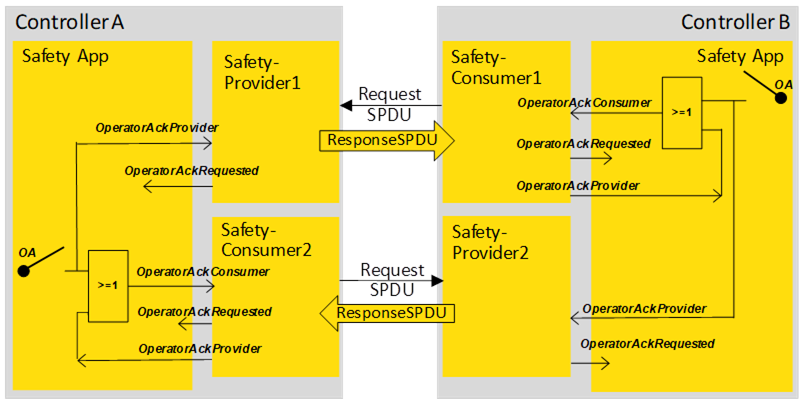This document supports Operator Acknowledgment both on the SafetyProvider side and on the SafetyConsumer side. For this purpose, both the interface of the SafetyProvider and the SafetyConsumer comprise a Boolean input called OperatorAckProvider and OperatorAckConsumer, respectively. The safety application can get the values of these parameters on the consumer side via the Boolean outputs OperatorAckRequested and OperatorAckProvider on the SafetyConsumers SAPI (see 6.3.4.2).
The following clauses show some examples on how to use these inputs and outputs. Dashed lines indicate that the corresponding input or output is not used in the use case. For details, see 6.3.3 and 6.3.4.

Figure B.1 – OA in unidirectional safety communication
In the scenario shown in Figure B., operator acknowledgment must be done on the SafetyConsumer side, operator acknowledgment on the SafetyProvider side is not possible.

Figure B.2 – Two-sided OA in bidirectional safety communication
In the scenario shown in Figure B.2, operator acknowledgment is done independently for both directions.

Figure B.3 – One sided OA in bidirectional safety communication
In the scenario of Figure B.3, an operator acknowledgment activated at controller A suffices for re-establishing the bidirectional connection. Both sides will cease delivering fail-safe values and continue sending process values. This is accomplished by connecting OperatorAckProvider with OperatorAckConsumer at the SafetyConsumer of controller B. Activating operator acknowledgment at controller B is not possible in this scenario.

Figure B.4 – One sided OA on each side is possible
Figure B.4 shows a scenario where an operator acknowledgment activated at controller A or controller B suffices for re-establishing the bidirectional connection. Both sides will cease delivering fail-safe values and continue sending process values. This is accomplished by the logic circuits shown in the safety applications.
Bibliography
- Object Management Group, Unified Modeling Language (UML), V2.5.1, 2017, https://www.omg.org/spec/UML/2.5.1/
- National Institute of Standards and Technology (NIST), Computer Security Resource Center, Recommendation for Random Number Generation Using Deterministic Random Bit Generators, SP 800-90A Rev. 1, June 2015
- Anwendungshinweise und Interpretationen (AIS) 20, Functionality classes and evaluation methodology for physical random number generators. Bundesamt für Sicherheit in der Informationstechnik (BSI), 1999.
- Anwendungshinweise und Interpretationen (AIS) 31, Functionality Classes and Evaluation Methodology for Physical Random Number Generators, Bundesamt für Sicherheit in der Informationstechnik (BSI), 2001.
- ISO/IEC 18031 Information technology, Security techniques. Random Bit Generation, 2011
- OPC 10010 (all parts), OPC Test Lab Specification
____________